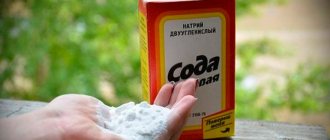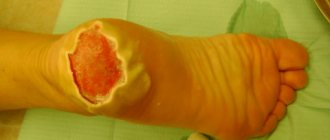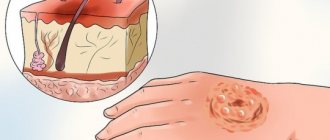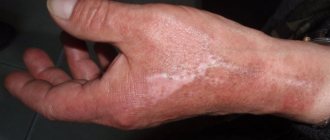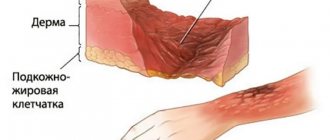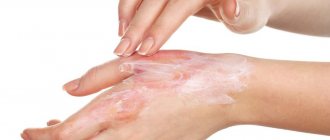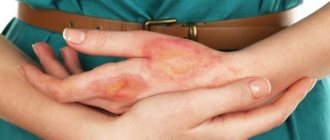Iodine in solution is widely used in medical practice for local treatment of intact skin. In some cases, it can cause a burn injury. What to do at home if your skin is burned by iodine? How and how to treat iodine burns to the face, arms, and legs? How long does it take for the skin to fully recover? You will read about this and much more in our article.
In medical practice, a five percent iodine solution diluted with ethanol and potassium iodide is used. Externally, the liquid looks like a substance with a dark red tint and a characteristic sweetish odor.
The active substance has a local irritant, antimicrobial, distracting effect, affects metabolism and enhances dissimilation processes. It is used exclusively externally, and only on intact skin with mandatory control of the application process.
What to do if you are burned by iodine
An obvious disadvantage of iodine is its incompatibility with a number of drugs for topical use - essential oils, brilliant green, ammonia, which significantly narrows the scope of use of the product. In modern practice, doctors are increasingly abandoning the drug in favor of safer and more practical analogues. If the skin is damaged, it is recommended to perform the following actions:
- Qualitative and quantitative assessment of pathology. If the burn affects more than 1% of the body surface, which corresponds to the size of the palm of an adult, you need to call an ambulance to the scene or go to the hospital yourself. If the severity is mild, a chemical burn with iodine can be treated at home.
- Washing. Skin burned with iodine is exposed to cool water pressure for 15-20 minutes.
- Secondary processing. A thick soap solution is used as a substance neutralizer, applied evenly to the damaged epithelium and nearby skin. It is advisable to use classic alkaline soap without fragrances or other additives.
Damage to the mucous membranes with iodine solution manifests itself much more intensely. In this case, even with a small area of damage, it is worth seeking qualified medical help.
Before contacting a doctor, the eyes and mouth should be rinsed with plenty of plain clean water. A standard soda solution is not effective here, since iodine easily dissolves in bicarbonates and forms stable compounds.
Causes of burns
The free sale of iodine tincture in pharmacies creates a false impression of its harmlessness. Like any drug, it has its side effects, and if used incorrectly, it can cause serious damage. The main errors are caused by violation of the rules for use and storage of the drug.
The most common of them:
- long-term exposure to the substance, use of iodine tincture for lotions;
- applying iodine directly to the wound;
- treatment of mucous membranes (tonsils, eyes, gums, oral cavity);
- repeated treatment of the same area of skin without observing a time interval;
- the use of iodine tincture for the prevention and treatment of iodine deficiency;
- storage in a place accessible to children;
- storing the drug near food products, or in containers without appropriate labeling;
- using a medicine without first testing for sensitivity to its components.
When purchasing the drug, be sure to read the instructions for use. This can avoid negative consequences and mistakes arising due to lack of knowledge.
Not Recommended Actions
The following actions are not recommended:
- Rub eyes and/or mucous membranes. The burn can cause severe itching and pain. Mechanically, a person tries to wipe the site of injury, which aggravates the pathological process,
- Treat the epithelium with potentially hazardous substances. When a chemical burn occurs, it is prohibited to use most common local remedies, often used in folk practice. We are talking about sunflower oil, brilliant green, fat, alcohol, egg yolks, baby powder, urine, and so on. Before providing qualified medical assistance, it is allowed to apply clean water or a soap solution,
- Contact heat or cool the damaged area. Cool the skin and mucous membranes only with cool, clean water, and not directly apply ice. Heating is prohibited as it activates a chemical reaction.
First aid
Correctly provided first aid for burns can reduce their manifestations to a minimum, as well as stop deeper tissue damage. It is more difficult to treat burns with iodine in a child than in adults, but their healing speed is faster.
If an iodine burn occurs on the skin, the first step is to rinse it with plenty of water. You can use tap water. The water temperature should be cool. It takes a long time to rinse - from a quarter to half an hour. Skin burns with iodine do not require the use of cold water or ice, since no thermal damage occurs.
To remove remaining iodine, use starch. To do this, you need to make jelly from it and smear the damaged area. If you don’t have starch on hand, you can use foods rich in this polysaccharide in your kitchen. Oatmeal, grated raw potatoes or pumpkin will do. Starch or products containing it should be kept at the damaged site for about half an hour. You can also use a raw egg to neutralize iodine. Once the wound is cleaned, a clean bandage should be applied to prevent germs from entering the wound.
If iodine gets into your mouth, rinse it with plenty of water. After which you can rinse your mouth with milk or jelly. If you swallow iodine tincture, you need to take a large amount of water, wash it down with milk or jelly, then be sure to consult a doctor. Inducing vomiting is not recommended due to the risk of re-exposing the esophagus to iodine. The stomach should be rinsed using a probe.
If iodine gets into your eyes, rinse them with plenty of water. To do this, you need to fill a basin with water, lower your head into it, open your eyes and blink.
Do not open a blister resulting from a burn yourself, as the risk of introducing an infection into the burn wound is very high.
Related article: is it possible to pierce a burn blister?
Causes of burn injury
Iodine is considered a fairly toxic element, which, when used systemically in its pure form, can cause damage to the cardiovascular system, kidneys and other internal organs. Naturally, a five percent solution in ethanol is less hazardous to health, but it must be used with great caution. Common causes of burns include:
- Incorrect use of the product. Oral use of the drug, the use of iodine solution to rinse the rectum, and other measures can cause severe chemical burns and complex intoxication of the body,
- Using too concentrated a solution. Pharmacy chains sell a 5% alcohol solution of iodine. However, in other areas of activity the substance may be present in higher concentrations. If it is used on the skin or mucous membranes, it leads to the development of pathology,
- Treatment of large surface areas of the body. Iodine is not intended for extensive treatment of the epithelium - it is used limitedly and locally.
Allergy to iodine and use of contrast media
Contrast agents are derivatives of triiodobenzoic acid and contain small amounts of free iodine. Adverse reactions to these substances can be classified as idiosyncratic or non-idiosyncratic.
The mechanisms of idiosyncratic reactions are unknown. Among the theories that explain them is the allergy theory, which suggests that either the contrast agent or iodine itself acts as a hapten, causing a specific immune response. An antigen-antibody reaction then occurs when the patient is re-injected with iodine-containing contrast agent. These drugs can lead to the formation of antigenic iodine proteins in vitro. However, the same researchers were subsequently unable to demonstrate a significant relationship between hypersensitivity to contrast agents and the presence of lymphocytes that specifically react to these substances or to iodide. Additionally, attempts to induce antibody production in vivo in animals have been unsuccessful despite optimal conditions.
Therefore, it is unlikely that the mechanism of idiosyncratic reactions to contrast media is based on a specific immune response (i.e., a true allergy), and, more likely, such reactions occur due to the activation of complement and other mediators of nonspecific immunity. Therefore, idiosyncratic reactions to contrast agents are best referred to as anaphylactoid, pseudoallergic, but not allergic. In addition, activation almost certainly occurs in response to the appearance of a whole molecule of contrast agent rather than free iodine. For example, none of the 23 patients with documented hypersensitivity to contrast agents had a similar reaction to subcutaneous sodium iodide.
Non-idiosyncratic reactions are due to direct toxic or osmolar effects. The only adverse effect of a contrast medium that can be intelligibly explained by free iodine is “iodine pig” and other manifestations of iodism. “Iodine mumps” is manifested by swelling of the submandibular, sublingual and parotid salivary glands after intravenous administration of an iodine-containing contrast agent. It is part of a group of non-idiosyncratic reactions due to impaired iodide metabolism due to iodine overload. All this is called iodism; it can also manifest itself as swelling of the lacrimal glands, runny nose, and skin rashes. Most of these cases occur in patients with weakened renal function (possibly due to decreased renal excretion, iodide concentrations in the body increase).
Symptoms of the pathological process
When the skin is damaged by iodine, the burn symptoms are usually not as significant as in cases with damage to the epithelium by acids, alkalis and other chemical compounds.
Photo of an iodine burn on the hand
We are talking about direct contact with a 5% solution of the product, sold through pharmacy chains. Typical symptoms of an iodine burn are:
- Itching and redness of the skin,
- Darkening of the epithelium
- Mild pain syndrome
- Slight swelling.
The symptoms of burns in high concentrations of iodine, as well as pathologies associated with contact of the product with the mucous membranes, eyes, esophagus and stomach, are more pronounced. Here, in addition to the basic manifestations, severe irritation, dyspeptic disorders, cough, lacrimation, as well as systemic toxic and allergic reactions can develop.
Iodine and seafood intolerance
“Food intolerance” (impaired tolerance, intolerance to foods) is a general term that includes all abnormal reactions to food, for example due to immune or non-immune mechanisms. Food poisoning caused by fish or shellfish can be a manifestation of an allergy, caused by an infectious agent, or toxins. These different mechanisms are of purely academic interest to the radiologist because they may be clinically similar to each other. However, these patients are best classified as seafood intolerant (impaired seafood tolerance) rather than seafood allergic.
Hypersensitivity reactions to seafood almost always begin to manifest clinically within 2 hours after ingestion. Patients experience pruritus, urticaria, angioedema, bronchospasm, rhinitis, diarrhea and shock. Clinical manifestation of an allergy can be life-threatening, even if the initial symptoms are minimal (for example, tingling in the mouth or throat). True allergic reactions are probably IgE-mediated. For example, 85% of patients with crustacean hypersensitivity have positive skin tests to shrimp extract, which in turn is used to detect IgE in tissue. The seafood allergy antigen is at least partially characterized as equivalent to the muscle protein tropomyosin. There was no evidence that the iodine content of seafood was associated with these reactions.
Treatment of burn wounds at home
After first aid has been provided, you can begin treating iodine burns to the skin. For 1st, partially 2nd degree burn severity, a wide range of home procedures are used, including drug therapy and traditional methods.
Use of drugs
For burns, local remedies are used mainly in the form of ointments, sprays, powders, creams, as well as anti-burn patches. It is better to discuss the use of systemic medications with a doctor - he will prescribe an individual regimen and monitor the recovery process. Typical treatment options:
- Antiseptics. Necessary for the initial treatment of the skin. Neutralize pathogenic microorganisms on the surface of the epithelium, reduce the risks of secondary bacterial infections. Safe drugs – Chlorhexidine, Miramistin,
- Steroids. When used topically, glucocorticosteroids do not have a systemic effect on the body and locally reduce the intensity of the inflammatory process. Used in the form of ointments. Safe drugs – Prednisolone, Hydrocortisone,
- Skin regenerators . Used after the end of the acute period of the pathological process, it is necessary to accelerate the process of restoration of the skin. The most commonly used are gels, dexpanthenol-based sprays,
- Other medicines. As part of professional drug therapy prescribed by a doctor, it is possible to use local antibiotics (Tetracycline ointment, Baneocin), antihistamines (Fenistil gel) and other medications as needed.
Traditional methods
A variety of traditional medicine recipes are actively used to treat all types of burns of 1st or 2nd degree severity. If the skin is damaged by iodine, topical products are suitable. Before using them, you must obtain the prior approval of your physician. Known and effective options:
- Potato. Large fresh potatoes are peeled, washed under cool water and crushed into porridge. The product is applied as a lotion to skin damaged by iodine solution. Directions for use: 3 times a day for a week,
- Cabbage . A clean and fresh cabbage leaf is poured with boiling water, then cooled in the refrigerator (50 minutes) and applied to the problem area for 30 minutes. The procedure is repeated up to 4 times a day for 3-4 days,
- Honey and sea buckthorn oil. 50 grams of fresh natural honey is mixed with 10 grams of sea buckthorn oil. A burn from iodine on the skin should be smeared with a thin layer of the mixture 4 times a day for 7 days.
Treatment with pharmaceuticals
Further therapy involves the use of special agents that will speed up the healing process. Finding them in a pharmacy and purchasing them will not be a problem. Their prices are low. Most modern drugs combine several effects at once: antiseptic, regenerating and analgesic. Therefore, you can choose a product based on your needs. The most famous and effective drugs are the following:
- Panthenol - promotes rapid regeneration of the skin and moisturizes the skin, preventing flaking;
- Levomekol - have an analgesic effect, prevents the development of bacterial infections and helps to quickly restore damaged skin;
- Rescuer - combines a mild calming effect with anti-inflammatory and wound healing;
- Vineshvsky ointment is an old and proven remedy that has a soothing effect on chemical burns;
- Solcoseryl is the best healing agent in this price category;
- Bepanen - promotes tissue restoration and prevents the development of pathogenic microflora in this area;
- Eplan is an analgesic and wound healing agent.
How to remove an iodine burn on your face
After the end of the reactive period of the pathological process and partial healing of the skin on the face after an iodine burn, a black spot remains, similar to the pigmentation of the epithelium. If the problem is not so visible on the body, upper and lower extremities, then in the facial area, where the skin does not have a sufficient layer of fat, they cause a serious aesthetic problem. get rid of iodine burn marks on your face in the following ways:
- Application of products containing milk. This option is suitable for dry skin. Typical products are natural yogurt, sour cream or yogurt. The whitening effect will be enhanced by adding strawberry and grapefruit juice. The procedure can be performed twice a day for 3-4 days,
- Using lemon . Boil a fresh large lemon, divided into two halves, in 300 milliliters of water for 10 minutes. Pour into a container and let it brew for one day. Wipe the damaged facial epithelium with liquid 3 times a day,
- Application of clay. Two tablespoons of white clay are diluted in warm water to a paste. 10 grams of parsley juice are added there. The mixture is stirred and applied as a lotion to problem skin twice a day for 5 days.
Of the professional cosmetic and medicinal products that help eliminate the effects of iodine burns on the face after the reactive period of the pathology, creams, masks and serums with a whitening and restorative effect are most often used.
They are used according to a single scheme by applying a thin layer of the product to problem skin several times a day for 1 week. The following are considered well-known and effective:
- Cream-active Snow White from Biocon,
- Vitex intensive serum,
- Whitening cream Achromin,
- Uriage depigmenting serum,
- Realcosmetics lotion.
What to give preference, brilliant green or iodine?
Everyone's favorite brilliant green (from the French "brilliant"), originally from Latin and meaning "brilliant", was used as a dye for silk, wool and other fabrics. As it turned out, according to the method of exposure, iodine and brilliant green have great distinctive features. To effectively use both tools, you need to understand exactly how they differ from each other.
Did you know that iodine successfully dries the skin, but if used in excess it can burn it? Now you know! To avoid this, you need to apply the basic rule: under no circumstances apply iodine to open wounds - this can cause severe burns to the surface of the skin, unlike brilliant green. If you cut your finger, get an abrasion, bruise or cut, do not immediately run for iodine - you can aggravate the injury. It is much more logical to use Iodine in cases of sprains, bruises or joint diseases to improve blood circulation. In these cases, the “iodine grid” is the most effective way to recover faster.
Possible complications
Burns with iodine do not cause serious complications for health and life, unless we are talking about the internal use of a product with a high degree of toxic damage to the body. In general, local skin reactions, including allergic ones, are observed.
Another problem is epithelial pigmentation. When using pure iodine, the consequences for the human body are often very severe. The most predictable reactions include damage to the kidneys, cardiovascular system, complex dyspeptic disorders, and rapid pulmonary edema. The lethal dose of the substance is 3 grams if taken orally.
Iodine and antiseptics
The active substance in many antiseptics is polyvinylpyrrolidone iodine. He is being held in Betadine, Povidin. Polyvinylpyrrolidone (povidone) is a polymer similar to dextran. It acts as a carrier of diatomic iodine directly to the bacterial surface. Diatomic iodine is bactericidal, probably due to the inactivation of essential bacterial enzymes. Adverse skin reactions to the substance are rare, with only two reactions reported in 5,000 subjects. It is possible that these reactions were due to a skin irritant rather than an allergy, and in any case, iodine does not appear to be involved in the reaction. None of the five patients with a history of contact dermatitis after povidone-iodine application demonstrated a skin reaction after potassium iodide application. Systemic side effects are extremely rare. Transdermal absorption of iodine in newborns can lead to iodism. One case of systemic anaphylactoid reaction with vaginal use of povidone-iodine has been reported.
Clinical significance
Patients with a history of allergy to iodine or seafood should be questioned in more detail regarding the severity of the previous allergic reaction. If possible, you need to separate seafood allergies from other causes of seafood intolerance. A history of seafood allergy increases the risk of side effects when a contrast agent is administered threefold. As with any allergy, the nature and severity of the reaction should be considered when choosing the type of contrast agent and when determining the need for premedication. Allergy to seafood in itself should not be considered an absolute contraindication to intravenous contrast.
There is no reason to believe that an allergy to iodine, indicated by skin reactions when using antiseptics, will be of particular importance during the intravenous administration of contrast media.
Author of the article: Vorobets K.Yu.
Cross-reactivity and allergy to iodine
There is evidence of nonspecific cross-reactivity between contrast agents and allergies to seafood and other food agents. A large review found that allergic reactions occurred in 5% of 112,303 episodes of intravenous contrast agent administration. The relative risk of such reactions in patients with an allergy to seafood (diagnostic criteria not specified) was 3.0 (increased threefold - translator's note), while the risk in patients with an allergy to eggs, milk or chocolate was 2.9, 2.6 - in patients with an allergy to fruit or strawberries, 2.2- for patients with asthma. In other words, seafood increases the risk of a reaction to intravenous contrast media about the same as any other allergy. In addition, these data suggest that at least 85% of patients with seafood allergy will not have an adverse reaction when administered intravenous contrast media. The benefit/risk ratio should be taken into account for patients with seafood allergies if they need to be administered intravenous contrast agents, and premedication with corticosteroids should also be remembered. We are not aware of any studies of contrast media hypersensitivity in patients intolerant to povidone-iodine.
The likely mechanisms for idiosyncratic reactions to contrast media, seafood allergies, and dermatitis from povidone-iodine use are varied; nonspecific immune mediators are activated by a contrast agent molecule in one case, IgE-mediated hypersensitivity to fish muscle protein is observed in another case, and contact dermatitis develops due to the irritant effect in the third case. There is little evidence that elemental iodine or iodide causes idiosyncratic reactions when contrast media or povidone-iodine are used, and no evidence that it is involved in hypersensitivity when eating seafood. The belief that iodine promotes specific cross-reactivity between these substances is unfounded. Therefore, the term “iodine allergy” is unfortunate - it is chaotic and based on unsubstantiated beliefs. This term should be abandoned and replaced with more neutral formulations such as “hypersensitivity to contrast agents,” “impaired tolerance or intolerance to seafood,” and “povidone-iodine dermatitis.”
